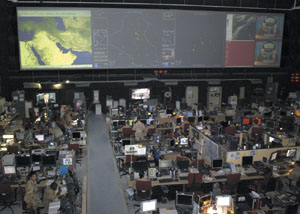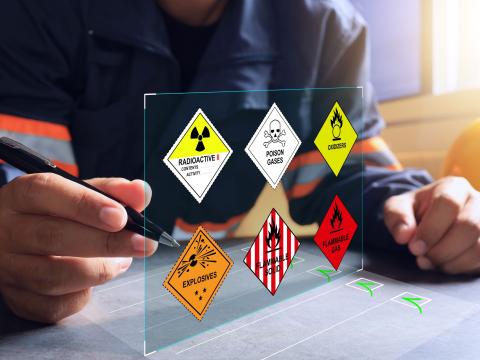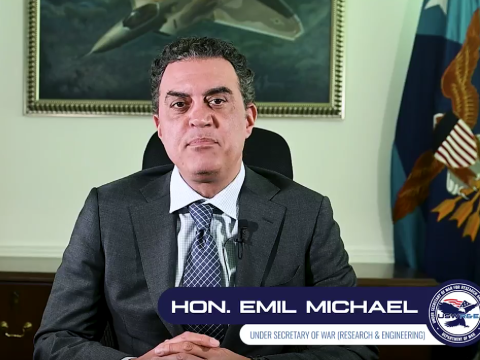War Validates Netcentricity Concept
 |
| The combined air operations center located in southwest Asia is one element of network-centric operations in current operations. The Office of Force Transformation is coordinating a series of case studies to evaluate how network centricity affects warfare. |
If actions speak louder than words, then current military operations are shouting volumes about the benefits of network centricity in warfare. Case studies sponsored by the U.S. Defense Department’s Office of Force Transformation present an abundance of hard evidence that networked forces can be up to 10 times more effective than non-networked troops in high-intensity conflict missions. In comparison to voice-only communications, what experts call the “information position” is between 10 and 100 times better not only for commanders but also for the individual warfighter. The studies also point out that even less-than-perfect networks can be valuable.
More than 15 case studies examine the behavior of networked military organizations during exercises, combat operations or peacekeeping operations. While some of them specifically explore U.S.-only military troops, others include coalition forces. A rigorous data collection and analysis methodology is being employed to ensure consistency, and so far, researchers have collected input during more than 200 person-to-person interviews and from more than 500 online surveys of warfighters and decision makers.
John J. Garstka, assistant director, concepts and operations, Office of Force Transformation,
Some case studies are complete; others are nearing completion, ongoing or in the planning stages. Many are collaborative efforts with coalition partners, including the
All of the research looks at the relationship of information and warfighters across what Garstka calls the three domains: information, cognitive and social, and physical. He contends that simply examining technological capabilities is not enough; the important insights are gleaned by looking at how people use technology and how it affects shared situational awareness, processes and mission effectiveness. “You make the case for return on investment by being able to move across the value chain, and this is important not just in the defense sector but in the commercial sector as well,” he says.
According to Garstka, the case studies demonstrate that networked forces out-fight non-networked forces across the board. The benefits run the gamut from significantly reducing casualties, including fratricide, to cultivating commanders’ tactical options and supporting necessary risk taking. The key appears to be the increased situational awareness that network centricity provides.
The research further proves that the benefits of sharing information do not depend on a massive uniform networking infrastructure; operational effectiveness improves even when information sharing is achieved by rigging together different systems. In fact, Garstka allows that seven blue force tracking systems that did not all interoperate were used in operations; however, gateways facilitated connectivity “in ways that were really pretty exciting,” he states.
Force XXI Battle Command Brigade and Below Blue Force Tracking (FBCB2 BFT) was one of several systems embedded in other command and control (C2) capabilities examined during the case studies. It is a combination of L-band satellite communications and back-up groundstations that are connected to the classified network.
“This is where Lt. Gen. [Steven W.] Boutelle [chief information officer, U.S. Army] basically pulled a rabbit out of a hat because this was the capability that the 4th Infantry Division had. It had been demonstrated, but it had been demonstrated in the line-of-sight mode with the EPLRS [Enhanced Position Location Reporting System] as the communications backbone. There wasn’t money, resources or time to install that with the 3rd Infantry Division, so what he did was combine two innovations—some innovations that had been developed in Kosovo—that called for an L-band satellite transceiver to be smashed up against FBCB2, and the new capability was called FBCB2 BFT.
“Fundamentally, the application was down scoped to be able to deal with the fact that there was limited L-band satellite bandwidth. It was installed on all these platforms—attack helicopters, tanks, fighting vehicles and HMMWVs [high mobility multipurpose wheeled vehicles] as well as C2 vehicles. This led to a picture that had all the blue forces on it. Lieutenant generals, major generals, brigadier generals, colonels, lieutenant colonels and company commanders had a picture like this. This was unprecedented in warfare. Never before had they had a picture like this on such a large scale. This was the 10x to 100x improvement in information—the ability to share information—and it was all because of the network. Without the network, this doesn’t happen, and frankly it didn’t need to be a perfect network. It was the fact that the force was networked that mattered,” Garstka claims.
Although the situational awareness of friendly forces was clear, the location of red forces was diffused when major combat operations began on March 29, 2003, he admits, because the pictures of allies and adversaries were on different networks. This led to some of the major challenges commanders faced, he states.
The information that blue force tracking technologies supply warfighters along with the ability to share that data consistently proved to be a valuable asset. For example, a case study that looked at air-to-ground communications between coalition special operations forces and aircraft during operations in western
Garstka emphasizes that the operations in western
The value of networking is further substantiated by military operations in southern
 |
| The Stryker Brigade Combat Team is the focus of two network-centric operations case studies. The first study examined the Stryker during a certification exercise at the Joint National Training Center. The second, which is ongoing, examines the effects of network centricity in stability and peacekeeping operations. |
Troops relied on this network for intelligence and logistics information, and Garstka says some of the challenges they faced early in combat operations were the result of this fragmentation of the network. He points out that this situation was similar to what occurred after Hurricane Katrina hit the
An ongoing case study illustrates how information can directly affect activity. It involves FBCB2 BFT during the march on
As Col. Marcone explained in an interview for the case study, although he was unaware of the alteration in plans, FBCB2 BFT allowed him to see that the 2nd Brigade had taken a different route, and he then knew that his mission had changed from being bridgehead security to conducting a hasty defense. In retrospect, Col. Marcone’s decision turned out to be one of the major tactical decisions in the war, Garstka says.
“This illustrates the network-disabled part of the discussion, and we’re still trying to figure out why this was the case. We’ve heard anecdotally that there were problems with his [Col. Marcone’s] intelligence feed. One of the things we’ve talked about is that because everybody had the blue picture, I think people assumed that if they had a picture that had blue and red on it, everybody else was seeing the same thing, and that wasn’t the case,” he relates.
“Moving from a bridgehead defense to a hasty defense turned out to be very, very important because there was an Iraqi counterattack and there were two companies on the far side of the bridge. Attacks were coming from the north and the south, and after the attacks started, Col. Marcone was able to connect to voice communications with the JointSTARS [Joint Surveillance Target Attack Radar System] and pick up the fact that there were lots of Iraqi forces coming down from the airport in
“You can see that it was really the tactical dominance of the
This ongoing case study also illustrates the importance of the relationship between technology and tactics, techniques and procedures. The density of deployment of FBCB2 enabled the 4th Infantry Division to determine a way to build the intelligence picture from the bottom up and the top down. Soldiers had trained and exercised with it at the national training center. However, Garstka believes that the 3rd Infantry Division did not have enough experience with it to trigger a decision to send e-mail or use SATCOM to improve situational awareness in terms of enemy positioning.
Because the case study is not yet complete, Garstka notes that the cause of the miscommunication cannot yet be definitively determined. “It may have been that these guys outran the intelligence—the preparation of the battlefield. The collection assets weren’t keeping up with the maneuver capabilities in this part of the battlespace. We will find out what the situation was as part of our case study,” he states.
Two of the case studies involve Stryker brigade combat teams and the benefits of network-centric operations when mobility is combined with information sharing. During a certification exercise held at the
An ongoing Stryker brigade combat team case study involves stability and support operations in
The information the case studies capture about the value of network-centric operations extends beyond the military community and out to the commercial sector, Garstka notes. At least in part, it underscores that the ability to share information allows commanders to make better decisions faster. As a result, commanders take risks they might not have taken because they can recover even before the enemy has had the chance to react. On the commercial side, the research helps companies better understand which capabilities are most useful to warfighters.
Garstka acknowledges that current case studies cannot fully demonstrate the ultimate value of network centricity because the U.S. Defense Department was in different phases of transformation, networking and the digitization journey at the time operations began. But this fact does not diminish their value. “A lot of really good signal officers did some heroic things in trying to make the networks that they had work. Our case studies have tried to capture it. We’re not aware of anybody else trying to do what we’ve done, and frankly we’re a little bit frustrated,” he says.
Although other organizations are collecting lessons learned from operation Iraqi Freedom, Garstka maintains that the process is like reading a book and skipping half of the chapters. “In some cases, they haven’t looked in the right places. In some cases, the lessons-learned teams focused on the operational level of war; this was at the tactical level. The lessons-learned teams were focusing on the maneuver part of the operations, and they didn’t focus on the information domain.
“This is a very difficult story to tell because we’re not just interested in how the network worked but also in the information position and how decision makers used that information to make decisions. Frankly, I think that the [lessons-learned] process is inadequate [to meet] the need based on where we are in the information age. We need to potentially consider transforming the process, giving it a different name and spending maybe 10 times what we’re spending if we really want to understand this,” he says.
Although the case study teams did not set out with a goal of making a business case for purchasing new technologies, Garstka emphasizes that the value of the studies crosses over into that area. “If you want to defend spending billions of dollars [on information technology], you have to be willing to spend millions, and frankly we haven’t done that. We will have spent a couple of million dollars on these case studies over a period of a couple of years, but I think that more people need to spend more money because this is about understanding the impact of information technology on warfare. Let’s do it in a way that has metrics and in a way that you can defend it and you can take it to the bank,” he states.
Web Resources
Office of Force Transformation: www.oft.osd.mil
Network-Centric Operations Case Studies: www.oft.osd.mil/initiatives/ncw/studies.cfm



Comments